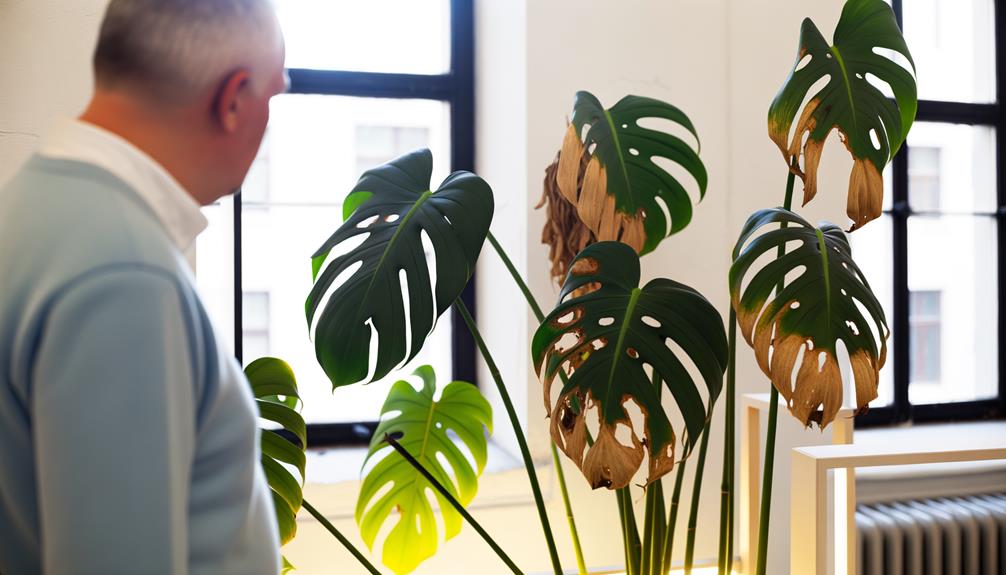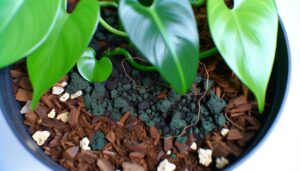Common Problems With Monstera Deliciosa: A Guide!
With your Monstera Deliciosa, you might see yellowing leaves due to overwatering or insufficient light. Root rot often follows from poor soil drainage and overwatering.
Pests like spider mites and mealybugs can infest if humidity is too low. Stunted growth typically results from insufficient light or poor soil.
Leaf drooping usually indicates incorrect watering schedules. Brown leaf tips signal improper humidity or water quality, and lack of fenestration is often due to inadequate light levels.
Addressing these issues with the right conditions will greatly enhance your plant’s health and appearance. For more detailed solutions, stay tuned.

Key Takeaways
- Yellowing Leaves: Ensure bright, indirect sunlight and proper watering practices to prevent yellowing.
- Root Rot: Improve soil aeration and repot with fresh soil to address root rot.
- Pest Infestations: Use horticultural oils or insecticidal soaps to manage common pests like spider mites and mealybugs.
- Stunted Growth: Place the plant in bright, indirect light and enrich the soil with nutrients.
- Brown Leaf Tips: Maintain humidity at 60-80% and use distilled or rainwater to avoid chemical damage.
Common Problems With Monstera Deliciosa and Solutions
| Problem | Symptoms | Causes | Solution |
|---|---|---|---|
| Yellowing Leaves | Leaves turning yellow, starting from the bottom | Overwatering or poor drainage, nutrient deficiency | Reduce watering, ensure well-draining soil, and check for root rot. Fertilize with a balanced mix. |
| Brown Leaf Edges | Leaf edges turning brown and crispy | Low humidity, underwatering, or too much direct sunlight | Increase humidity with misting or a humidifier. Adjust watering and avoid direct harsh sunlight. |
| Leggy Growth | Long, weak stems with fewer leaves | Insufficient light exposure | Move the plant to a location with bright, indirect light or use grow lights if natural light is limited. |
| Black Spots on Leaves | Dark, water-soaked spots on leaves | Fungal or bacterial infection due to excessive moisture | Remove affected leaves, improve air circulation, and avoid misting the leaves. |
| Stunted Growth | Slow or no new leaf development | Poor lighting conditions, nutrient deficiency, or root-bound | Ensure bright indirect light, feed with a balanced fertilizer, and check if the plant needs repotting. |
| Root Rot | Mushy, dark roots and foul odor | Overwatering or waterlogged soil | Trim affected roots, repot with fresh well-draining soil, and reduce watering frequency. |
| Pest Infestation | Presence of pests like spider mites, scale, or mealybugs | Poor air circulation or over-fertilization | Treat with insecticidal soap, neem oil, or wipe pests away with a damp cloth. Improve plant hygiene. |
Yellowing Leaves
Why do the leaves of your Monstera Deliciosa turn yellow despite your best care efforts? Yellowing can be due to several factors.
Insufficient light is a common cause; Monstera needs bright, indirect sunlight to thrive. Make sure your plant receives adequate lighting by placing it near a window but shielded from direct sunlight.
Overwatering is another culprit; Monstera prefers its soil to dry out slightly between waterings. Check the soil moisture regularly, and water only when the top inch feels dry.
Nutrient deficiencies, particularly nitrogen, can also lead to yellowing. Use a balanced, water-soluble fertilizer every month during the growing season.
Root Rot
Root rot, often caused by overwatering and poor drainage, can severely damage your Monstera Deliciosa’s root system and hinder its overall health. To diagnose root rot, look for these common symptoms: yellowing leaves, mushy roots, and an unpleasant odor.
| Symptom | Cause | Solution |
|---|---|---|
| Yellowing Leaves | Poor oxygen flow to roots | Improve soil aeration |
| Mushy Roots | Fungal or bacterial infection | Remove infected roots |
| Unpleasant Odor | Decomposing root tissue | Repot in fresh, dry soil |
Ensure your Monstera has well-draining soil and appropriate watering practices. Allow the top inch of soil to dry out before watering again. Use a pot with drainage holes to prevent stagnant water. Regularly inspect the root system to catch early signs of rot.
Pest Infestations
When caring for your Monstera Deliciosa, you’ll likely encounter common pests such as spider mites, mealybugs, and scale insects.
To manage these infestations effectively, use horticultural oils or insecticidal soaps while ensuring proper application techniques to avoid plant damage.
Regularly inspecting your plant and maintaining ideal humidity levels can also help prevent these pests from establishing a foothold.
Common Pests Encountered
Over time, Monstera deliciosa plants can become targets for a variety of common pests such as spider mites, mealybugs, and scale insects, each requiring specific management strategies to keep your plant healthy.
Spider mites are tiny arachnids that create fine webbing on leaves, leading to stippling damage and discoloration.
Mealybugs are small, cotton-like insects that cluster on stems and leaf nodes, secreting honeydew which can attract sooty mold.
Scale insects appear as small, brownish bumps on plant surfaces, sucking sap and weakening the plant.
Regularly inspect your Monstera for early signs of these pests. Use a magnifying glass if necessary, and keep your plant in ideal conditions to reduce the likelihood of severe infestations.
Effective Treatment Options
Implementing effective treatment options for pest infestations on your Monstera deliciosa involves a combination of targeted interventions. This includes insecticidal soap applications, which disrupt the pests’ cell membranes and dehydrate them. Another approach is using biological controls like introducing predatory insects such as ladybugs or predatory mites that naturally prey on common pests.
Maintaining ideal plant health is also crucial in managing pest infestations. Ensure your Monstera receives proper watering, lighting, and nutrients to boost its natural defenses. Regularly inspect your plant for early signs of infestation, such as discolored leaves or webbing, and take prompt action.
Stunted Growth
When your Monstera Deliciosa shows stunted growth, you should first evaluate its light exposure, as inadequate light can impede photosynthesis and overall development.
Next, assess the soil quality; compacted or nutrient-deficient soil can limit root expansion and nutrient uptake.
Providing sufficient light and enriching the soil can greatly improve growth and health.
Inadequate Light Exposure
Insufficient light exposure often leads to stunted growth in Monstera Deliciosa, as these plants rely on adequate sunlight to synthesize the energy required for healthy development. When your Monstera doesn’t receive enough light, photosynthesis slows down, reducing the production of essential sugars and starches.
Place your plant near a bright, indirect light source, such as a north or east-facing window. Avoid direct sunlight, which can scorch the leaves. If natural light is limited, consider using a grow light with a spectrum suitable for foliage plants.
Monitor your Monstera’s growth, noting leaf size and color; smaller, pale leaves indicate inadequate light. By ensuring proper light exposure, you’ll promote vigorous growth and vibrant, large leaves characteristic of a healthy Monstera Deliciosa.
Poor Soil Quality
Poor soil quality can severely hinder the growth of your Monstera Deliciosa, as these plants require well-draining, nutrient-rich soil to thrive. Without proper soil, your plant may show stunted growth, yellowing leaves, and reduced vitality.
Here are four critical soil-related factors to keep in mind:
- Drainage: Make sure the soil allows excess water to escape, preventing root rot.
- Nutrient Content: Use soil rich in organic matter to provide essential nutrients.
- Aeration: The soil should be loose to allow oxygen to reach the roots effectively.
- pH Level: Aim for a slightly acidic to neutral pH (5.5-7) to optimize nutrient uptake.
Leaf Drooping
Leaf drooping in Monstera deliciosa often indicates issues with watering, lighting, or root health that need immediate attention. First, make sure you’re watering properly; too much or too little can cause drooping. Use your finger to check soil moisture; it should be damp but not soggy. Next, assess the lighting conditions. Monsteras thrive in bright, indirect light. Insufficient light can weaken the plant, causing leaves to droop.
| Problem | Solution |
|---|---|
| Overwatering | Allow soil to dry slightly |
| Underwatering | Water thoroughly and regularly |
| Poor Lighting | Move to a brighter, indirect spot |
| Root Bound | Repot in a larger container |
Lastly, examine the roots. If they’re root-bound, repotting can alleviate stress and restore vigor to drooping leaves.
Brown Leaf Tips
Brown leaf tips in Monstera deliciosa typically signal issues with humidity levels, water quality, or nutrient deficiencies that demand prompt and precise adjustments.
To address these problems, consider the following:
- Humidity Levels: Monstera requires high humidity. Aim for 60-80%. Low humidity causes leaf tips to dry out and brown.
- Water Quality: Use distilled or rainwater to avoid chlorine and fluoride, which can harm leaf edges.
- Nutrient Deficiencies: Ensure balanced fertilization. A lack of potassium or magnesium can result in brown tips.
- Watering Practices: Overwatering can lead to root rot, causing brown leaf tips. Water when the top inch of soil is dry.
Lack of Fenestration
While brown leaf tips indicate immediate care issues, a lack of fenestration in Monstera deliciosa points to environmental factors influencing its growth patterns.
Insufficient light is the primary cause; these plants require bright, indirect light to develop their characteristic leaf splits. Guarantee your Monstera receives adequate illumination, ideally near a north or east-facing window.
Additionally, suboptimal humidity levels can impede fenestration. Maintain humidity around 60-70% using a humidifier or pebble tray.
Nutrient deficiencies also play a role; feed your plant with a balanced, water-soluble fertilizer every 4-6 weeks during the growing season.
Lastly, make sure your Monstera has ample space to grow, as confined roots can stunt development. Addressing these factors will encourage proper fenestration.
How Do You Know If Monstera Deliciosa Is Dead
To determine if a Monstera deliciosa is dead or dying, you can look for several key signs:
1. Check the Leaves
- Yellowing or browning: A few yellow or brown leaves can be normal, but widespread discoloration may indicate an issue. Browning at the edges or tips may result from underwatering, while mushy brown patches can signal overwatering or root rot.
- Crispy, wilted leaves: Leaves that are dry, crispy, and shriveled are often a sign of underwatering or extreme heat and may indicate the plant is in poor health.
- No new growth: If your Monstera has stopped producing new leaves during the growing season (spring and summer), this can be a sign that it is struggling or dying.
2. Check the Stems
- Mushy stems: A healthy Monstera should have firm stems. If the stems feel soft and mushy, especially near the base, this could indicate root rot, which is often fatal if not addressed.
- Stems drying out or shriveling: This can indicate dehydration or severe stress.
3. Inspect the Roots
- Rotting roots: If you suspect the plant is dying, carefully remove it from its pot and inspect the roots. Healthy roots should be white or light tan. If you notice black, mushy, or foul-smelling roots, this indicates root rot.
- No root growth: If the roots are overly compacted or appear shriveled and dry, the plant might be dying due to lack of nutrients or water.
4. Wilting
- If the plant is persistently wilting even after watering, this is often a sign of severe root damage or rot. Sometimes, wilting is a response to overwatering or poor drainage.
5. Aerial Roots
- If the plant’s aerial roots are dry, brittle, or shriveling, this can indicate that the plant is not receiving enough moisture or nutrients.
If your Monstera shows multiple severe symptoms (like mushy stems, rotting roots, and wilting), it may be dead or in critical condition. However, if only a few parts are affected, there may still be time to save it with the right care (e.g., repotting, adjusting water and light conditions).
Conclusion
To sum up, addressing common issues with Monstera deliciosa, such as yellowing leaves or root decay, might appear challenging, but it’s manageable with proper attention.
You may believe it’s excessive effort, but grasping the plant’s requirements guarantees a flourishing, fenestrated beauty.
Routine inspections for pests, suitable watering, and maintaining good light conditions will maintain your Monstera’s health.
Keep in mind, the time and care you dedicate result in a lush, dynamic plant that brings a hint of nature to your surroundings.






